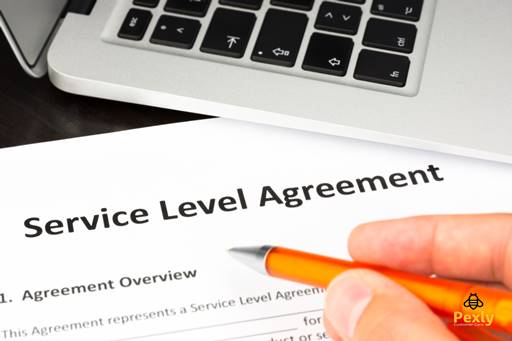
One of the most important aspects of customer-vendor relationships is the SLA. Basically, this document stipulates what the parties can expect from one another and brings both sides on the same page in terms of the scope of services provided.
In this article, we will take a look at the SLA meaning in business, more specifically, outsourcing customer support. Let’s start with the basics and take a look at what does SLA stand for.
What Does SLA Stand for in Business?
SLA stands for service level agreement. The purpose of the SLA is to offer some understanding between the client and the service provider. Traditional SLAs define the expectations and may also be used between various departments within that same organization. The SLA can consist of only a few sentences or many documents worth of provisions and stipulations.
Now that we know what is SLA in business let’s move on to things that are included in the SLA.
What should Service Level Agreement include in Customer Service Support?
A good SLA in the business of customer service support includes information that sets client and service provider expectations by describing the roles and functions of each party:
- Agreement Summary – This includes information on the parties involved and when the agreement takes effect. Also, briefly outline the services being provided.
- Description of services – Provide some information on the services you will be providing.
- Service availability: Input information about when the customers can contact the agents for live support and how they can get help outside normal business hours.
- Response and resolution times: The SLA time states how long it will take to provide a response and resolve an issue. An SLA time frame will align with industry standards.
- Performance metrics: Be sure to note here the specific metrics that will be tracked to gauge the level of support.
Now that we looked at what SLA means in the business of customer service and the SLA acronym in business let’s move on to the SLA model.
What is an SLA Model?
To get a better understanding of the SLA in BPO model, you need to know the performance metrics that are usually involved:
- Availability & uptime percentage
- Various performance benchmarks
- Response time (often associated with the work of customer service)
- Problem resolution time
- Usage statistics that will be provided
Let’s now go beyond the SLA business acronym and go deeper to look at the various types of SLAs
The 3 Types of SLAs
- Customer-based SLA: This type of agreement consists of an individual client or group that sets a specific standard for support.
- Service-based SLA: A specific standard for support that’s promised to all customers who are using a particular service or product.
- Multilevel SLA: A multipart agreement that’s split into different levels, each addressing different sets of customers.
Let’s now look closer at the SLA definition of business by looking at the main components of an SLA.
Main Components of an SLA
A good SLA includes more information than the SLA time meaning. IT sets client and service provider expectations by describing the roles and functions of each party.
- Agreement Summary: Start by stating the parties involved and the effective date and briefly outlining the services being provided.
- Description of services: Clearly detail the services your support agents will provide for customers.
- Service availability: Include when and where customers can contact your agents for support. This doesn’t always have to be live support, as you can use AI-powered chatbots or self-service options to ensure customers can get help outside of normal business hours.
- Response and resolution times: State the amount of time it will take to provide a response and resolve an issue. Set time frames that align with industry standards.
- Performance metrics: Mention specific metrics that will be tracked to measure the quality of support. You may want to consider including these key performance indicators (KPIs) that often appear in SLAs.
What Makes a Good SLA in Customer Support?
A good SLA in customer support will be comprehensive. It will account for various aspects of the client-provider relationship. This includes things like:
- Agreement Overview: Lists the basics that are included in the SLA, when it takes effect and a description of the services provided.
- Description of services – Just like the name suggests, this is a description of the services that will be provided, but also information about the delivery, dependencies, processes, and other details.
- Exclusions: If there are things that are not covered by the SLA, be sure to list them here.
- Service performance: In this section, you want to list the metrics that will be used to measure the performance.
How to Set Metrics in an SLA
Metrics are used to give an understanding of how well the service provider is performing their job. You need to select the metrics that will be fair for both sides, which can be challenging. Sometimes the service provider will not be able to control whether it performs as specified, in which case, it would be unfair to hold them accountable. The SLA also needs to specify a clear and reasonable baseline for the chosen metrics, which should be refined as needed.
What is the Difference Between KPI and SLA?
While we have already looked at what SLA stands for and the SLA definition in business, there is still confusion between SLA and KPI. Both the Service Level metrics and KPIs provide useful information. Service Level metrics provide information on the baseline performance expectations. An agreement toward meeting those expectations is regarded as an SLA term.
KPIs provide information on the efficiency and success of meeting organizational goals or expectations. While SLAs are used to ensure that service level metrics don’t fall below certain metrics criteria, KPIs help ensure that specific performance improvements and results are met adequately or exceedingly. In order to improve service level performance, the engaged service provider, internal or external, is expected to adopt appropriate actions.
Service Level Management
The practice of Service Level Management (SLM) gives assurance to the service consumer that a provider will deliver a level of service that meets their needs. The purpose of the SLM practice is to set clear business-based targets for service performance so that the delivery of a service can be properly assessed, monitored, and managed against these targets. SLM involves service-level activities, including:
- Defining service levels
- Documenting
- Actively managing them
What Professional SLA Management Services Should Include
SLAs are used to measure the performance of services from the customer’s point of view, and it is important that they are agreed upon in the wider business context. Some of the key requirements for successful SLA management include the following:
- They must be related to a defined ‘service’ in the service catalog. Individual metrics without a specified service context are unhelpful.
- They should relate to defined outcomes and not simply operational metrics. This can be achieved with balanced bundles of metrics, such as customer satisfaction and key business outcomes.
- They should reflect an ‘agreement’: an engagement and discussion between the service provider and the service consumer. It is important to involve all stakeholders, including partners, sponsors, users, and customers.
Types of SLA Penalties
There are a variety of penalties that may be incurred from service-level violations. The three most common are:
- Financial penalties. With these, the vendor will be required to pay back to the customer the number of damages that were agreed upon in the contract. This may not amount to a full reimbursement of the service fee paid by the customer for the job.
- Service credits. With these, the vendor will reimburse the customer for the cost of the work that was done or offer credit for future work to be done. In either event, funds are not being transferred.
- License extension or support. With this, the vendor will be required to extend the license’s term or offer further support to the customer without charge, which may include development and maintenance.
Who Provides the SLA?
The SLA is provided by both sides, but mostly by the company that outsources the customer support. This allows the organization to customize its various SLAs to meet specific service and customer requirements. In fact, there might be cases in which a company may provide several SLAs for a single service, with each SLA reflecting different levels of service at different price points. However, because SLAs are usually prepared by the vendor, they may favor the service provider over the customer. As such, it can be helpful to encourage clients to review SLAs—and to even consider bringing in legal counsel, where appropriate—to ensure that the SLA is satisfactory before making any formal commitments. This will help prevent issues where customers feel as though they have been misled.
How Can I Verify Service Levels?
In order to enforce a service level agreement, verification of the service levels in question is necessary. Many service providers will make service level statistics available, often online. Through the website, the customer may then check on whether the appropriate service level is being maintained and, if not, whether they are entitled to service level credits or other compensation as set out in the contract.
Often, such systems and processes are handled by a third-party company that specializes in such work, and it is recommended that the customer and this company are in contact during the contract negotiation so as to eliminate any confusion about the service levels to be tracked and how they will be tracked. Third-party tools that automatically capture service-level performance data may also be employed.
SLAs and Indemnification Clauses
Having an indemnification clause in a service-level agreement is highly recommended. In a service-level agreement, an indemnification clause will require the service provider to indemnify, or hold harmless, the customer for costs incurred due to a breach of the warranty. It will also require the service provider to pay the customer any litigation costs from third parties due to a breach of the warranty. A standard service level agreement offered by the service provider will likely not include this provision. If so, it should be added, although further negotiation on its finer points will probably be desired by the service vendor.
Revising and Changing the SLA
Since business requirements are subject to change, it’s important to ensure that an SLA is revised regularly. This will help to always keep the agreement in line with the business’s service level objectives. The SLA should be revised when changes the following occur:
- A company’s requirements
- Workload volume
- Customer’s needs
- Processes and tools
SLA Calculation
SLA assessment and calculation determine a level of compliance with the agreement. You might be wondering how you even calculate an SLA. There are many tools for SLA calculation available on the internet. The real question is what exactly should be calculated.
SLA Uptime
Uptime is the amount of time that a service is available and operational. It is generally the most important metric for a website, online service, or web-based provider. Sometimes uptime is mistaken for SLA, but uptime is nothing more than a very common metric in online services that are used to measure SLAs, not an SLA, which, as we have seen before, is something much broader.
The trade-off is downtime – the amount of time a service is unavailable. Uptime is usually expressed as a percentage, such as “99.9%”, over a specified period of time (usually one month). For example, an uptime of 99.9% equals 43 minutes and 50 seconds of inactivity.
Incidents and SLA Violations
Some businesses prefer or are obliged to have a certain Service Level Agreement in place. The SLA sets a definite time frame in which tickets have to be answered, or chats and calls have to be picked up. If they are not answered or picked up within the specified timeframe, SLA Violation occurs. Normally, if too many SLA Violations occur, a company should reconsider its SLA setups and preferences or should empower its workforce with more agents or with better help desk tools.
Trust Pexly With All of Your Customer Support Needs
In this article, we looked extensively at SLAs within the context of customer support outsourcing. If you are looking to outsource your customer support to a vendor that will meet their SLA obligations, consider Pexly to set up your offshore teams. Contact us today to learn more about how we can help you.



